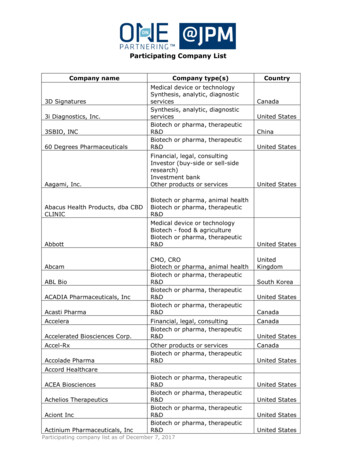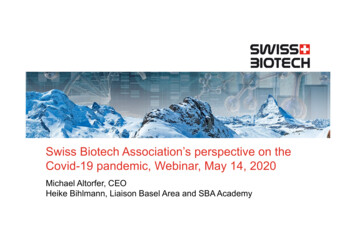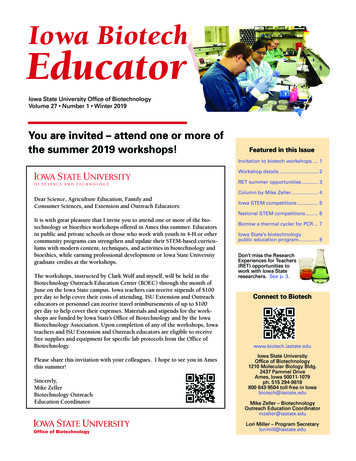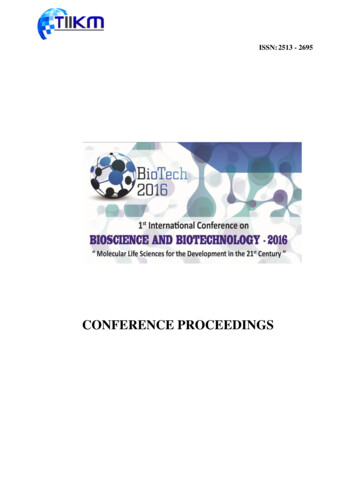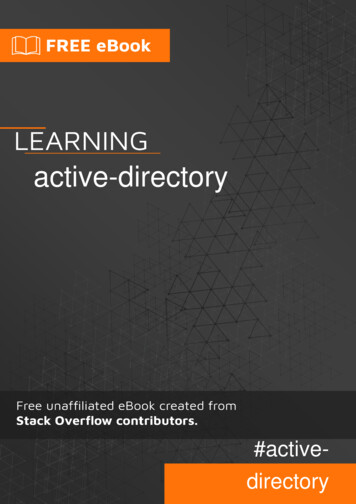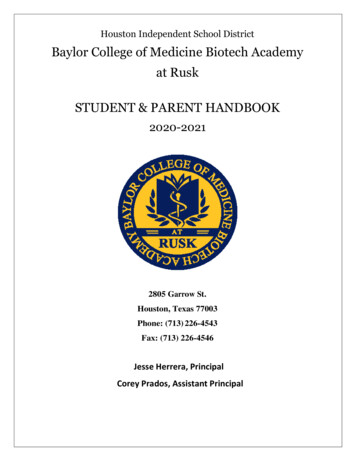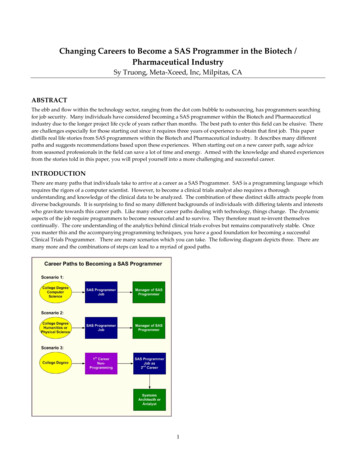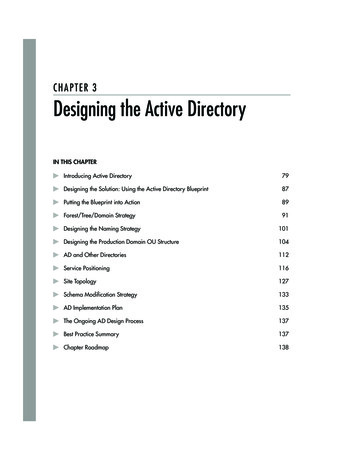
Transcription
Disclaimer Certain statements made during the course of this presentation are forward-looking statements. Such forward-lookingstatements involve known and unknown risks, uncertainties and other important factors that could cause the actual results,performance or achievements of the company, or industry results, to differ materially from any future results, performance orachievement implied by such forward-looking statements. Statements made during the course of this presentation that are forward-looking are based on the company’s currentbeliefs regarding a large number of factors affecting its business. There can be no assurance that (i) the company hascorrectly measured or identified all of the factors affecting its business or the extent of their likely impact, (ii) the availableinformation with respect to these factors on which the Company’s analysis is based is complete or accurate, (iii) thecompany’s analysis is correct or (iv) the Company’s strategy, which is based in part on this analysis, will be successful. All forward-looking statements speak only as of the date of this presentation or, in the case of any document incorporatedby reference, the date of that document. All subsequent written and oral forward-looking statements attributable to thecompany or any person acting on the company's behalf are qualified by this cautionary statement. The company does notundertake any obligation to update or publicly release any revisions to forward-looking statements to reflect events,circumstances or changes in expectations after the date of this presentation.2
Active Biotech in BriefDetailed analysis has re-directed our effortsFinance & Corporate Focus on specialist disease areas of unmet medical need Listed on Nasdaq Stockholm (ticker: ACTI)and potential value Hematological cancersInflammatory eye disordersSelected solid tumors – partnered project Opportunity to leverage prior generated data to accelerate Market cap SEK 261 M, USD 26.8.M* Strong shareholder base, incl MGA Holding, AP3 and AP4 Funded in 1998 as spin-off from Pharmacia, based in Lund,Swedendevelopment Multiple near-term clinical milestonesExperienced leadership & board with complementary skills Focused project-oriented organization Expanded board with topic expertise Broad international network of KOLs and experts* As of 26 April, 20223
Immunomodulation to Treat Cancer and InflammationSmall molecules- myeloid cell modulationTasquinimodAntibody based immunotherapy- tumor targeting superantigenNaptumomabTumor killingTumor killingLaquinimodImmune toleranceAbbrev:, MDSC – Myeloid derived suppressor cell; TAM – Tumor-associated macrophage,HDAC4 - histone deacetylase 4; HIF-1α - Hypoxia-inducible factor-1α, VEGF - Vascularendothelial growth factor; TSP-1 – Thrombospondin-1 APC- Antigen Presenting Cell, T regRegulatory T cell, Th 1-T helper cell 1, Th17-T helper cell 174
A Growing Clinical Pipeline in Specialist Indications5
Tasquinimod: New Method to Treat Blood CancersMode of Action Oral small molecule immunomodulatorIndication Multiple myeloma and Myelofibrosis Phase Ib/IIa study in relapse or refractory multiplemyeloma patients ongoingSafety 1,500 persons exposed, 650 person years of exposureRegulatory Regulatory package of preclinical and clinical safetyCMC Full commercial scale CMC documentation availableIP and exclusivity Protected by patents to at least 2035Orphan drug designation granted for multiple myeloma inthe USClinical statusAbbrev: CMC - Chemistry, Manufacturing and ControlsTASQUINIMOD6
Multiple Myeloma: An Incurable Blood Cancer Multiple myeloma develops in the bone marrow Survival has increased due to more treatmentoptions available. Median survival is nowestimated to 8-10 years from diagnosis Patients relapse and eventually die due toresistance to current treatmentsUncontrollable growth of plasma cellsFormation of new blood cells preventedLeads to bone pain, fractures, anemia and othersevere complications, e g renal failure andinfectionsThe medical need remains highTASQUINIMOD7
Novel MoA Complementary to Existing Drug ClassesTasquinimod restores immune function and decreasesvascularization of the tumor microenvironmentMain drug classes used todayDrug meinhibitors (PI)ProteasomeMonoclonalantibodiesCD38 and SLAM7Alkylating agentsDNA alkyl groupsCAR-T, BiTE, ADCBCMAAbbrev: MDSC – Myeloid derived suppressor cell; TAM – Tumor-associated macrophage, HDAC4 - histone deacetylase 4; HIF-1α - Hypoxia-inducible factor-1α, VEGF - Vascular endothelial growthfactor; TSP-1 – Thrombospondin-1, IMiDs – Immunomodulators, PI - Proteasome inhibitor, DNA - deoxyribonucleic acid, SLAM7 - Signaling lymphocytic activation molecule F7, CAR T -Chimeric antigenreceptor T cells ; BiTE - Bi-Specific T-cell Engager; ADC - Antibody-drug-conjugatesTASQUINIMOD8
Multiple Myeloma: Market Driven by Novel Treatments 1 million people 315,000people 350,000peopleTotal patients treated Duplet Triplet Quadruplet Quintuplet multiple myelomadrug combination regimensTreated in 2 lineTreated in 3 linesCommercial potential: 1bn/yearEight major markets: 27bn insales in 2027Source: GlobalData March 2019, 8 Major Markets (US, EU5, Japan, China). Presented data are based on 2027 forecast numbersTASQUINIMOD9
Superior Anti-tumor Response in Combination withProteosome Inhibitor or IMiD in Multiple Myeloma ModelTasquinimod in combination withan immunomodulatory drug (IMiD)400300300200***100001020Vehicleixatasqixa tasq304050Days after tumor tasqlentasq len400Tumor Area (mm2)Vehicletasqborttasq bortTumor Area (mm2)Tumor Area (mm2)Tasquinimod in combination with proteasome inhibitors (PIs)50Days after tumor inoculation0204060Days after tumor inoculation80Multiple myeloma tumors were established by subcutaneous injection of human H929 cells into NSG mice. Mice were treated with tasquinimod, bortezomib, ixazomib or lenalidomideAbbrev: tasq – tasquinimod; ixa – ixazomib; len – lenalidomideSource: Lin et al., Poster presented at the Virtual Edition of the 25th European Hematology Association (EHA) Annual Congress Meeting, 2020TASQUINIMOD10
Ongoing Phase Ib/IIa Study in Multiple MyelomaPatientsMM relapsed or refractory after 1 line of anti-MM therapy and refractory orintolerant to lenalidomide, pomalidomide, bortezomib, carfilzomib, and an antiCD38 mAbPatientsMM relapsed or refractory after 1 line of anti-MM therapy andrefractory to most recent PI/IMiDcombinationPrimary endpointSafety & tolerability,(MTD)Key secondaryendpointPreliminary efficacy byclinical response (ORR)Part A1Dose escalation of tasquinimodPart B1Dose escalation of tasquinimod incombination with standard oral regimenPart B2Expansion at MTD of combinationPrinciple investigator: Dan Vogl, MD MSCE, Abramson Cancer Center Philadelphia, University of PennsylvaniaObjectives: Establish the Maximum Tolerated Dose (MTD) and optimal schedule of single-agent tasquinimod in patients with relapsed orrefractory Multiple Myeloma (rrMM) Investigate the MTD of tasquinimod in combination with ixazomib, lenalidomide, and dexamethasone (IRd) Assess the preliminary efficacy of tasquinimod alone and in combination with IrdN up to 34 patientsTASQUINIMOD Abbrev: MTD - Maximum Tolerated Dose, ORR – Overall Response RateClinicaltrial.gov: NCT0440516711
Safety Readout of Part ADose Escalation Single Agent Tasquinimod Patients (N 10) Heavily pre-treated, median of 8 prior lines of therapy8 of 10 patients triple-class refractory to IMiDs, proteasome inhibitors and anti-CD38 monoclonalantibodies Primary endpoint – optimal dose and treatment schedule of tasquinimod Defined at 1 mg per day after a one-week run in of 0.5 mg tasquinimod dailyTasquinimod was generally well tolerated and the safety profile resembled the previous profiledemonstrated in solid tumors Key secondary endpoint – preliminary anti-myeloma activity* Two patients achieved significant periods of stable disease after documented disease progression,suggesting anti-myeloma activity of tasquinimodNo formal response confirmed*Using the IMWG Uniform Response CriteriaTASQUINIMOD12
Tasquinimod: MyelofibrosisMyelofibrosis (MF) – In BriefCollaboration with Erasmus MC A rare blood cancer with an annual incidence of 0.4 1.3 cases per 100 000 people in Europe Global patent license agreement between Active Biotech Market estimated at 1BUS Clinical PoC funded by Oncode, planned to start H1 2023 Symptoms include anemia, changes in white blood cellcounts, enlargement of the spleen and increased riskfor infections Associated with shortened survival due to bone marrowfailure and transformation into acute leukemia Current treatments: bone marrow transplantation, JAKinhibitors and therapies to manage anemiaAbnormal production of blood-forming cells replacinghealthy bone marrow with scar tissue (fibrosis)High medical need for disease modifying treatmentTASQUINIMODAbbrev: JAK inhibitor - Janus kinase inhibitorsand Oncode Institute (on behalf of Erasmus MC) signedFeb 2022Tasquinimod reduces fibrosis in anexperimental model of myelofibrosisSource: Leimkühler et al. Cell StemCell. 2021 Apr 1;28(4):637-652.e813
Laquinimod: Treatment of Inflammatory Eye DisordersMode of Action Small molecule immunomodulatorIndication Inflammatory eye disorders – non-infectious non-anterior uveitisClinical status Phase I study of eye drops in healthy subjects ongoingSafety 5,000 persons exposed, 14,000 person-years of exposureRegulatory Regulatory package of preclinical and clinical safetyDrug supply Full commercial scale CMC documentation availableIP and exclusivity Protected by patents and patent applications to 2040Opportunity for orphan drug designation in uveitisAbbrev: CMC - Chemistry, Manufacturing and ControlsLAQUINIMOD14
Non-Infectious Uveitis: A Severe Eye Disorder Inflammation affecting iris, ciliary bodyLaquinimodand the choroid Subtypes based on location of theinflammation Symptoms include eye pain, ocularredness, tearing and decreased vision Sometimes associated withunderlying systemic disease The third leading cause of blindnessin the western worldLAQUINIMODCurrent treatment of non-infectious uveitis1st line of treatment Corticosteroids, oral, intravitreal or periocular injection2nd and 3rd line of treatment Immunosuppressants, oral Biologics – anti-TNFα antibodies (Humira ), subcutaneous15
Non-Infectious Uveitis: High Unmet Need About 35% of the patients suffer from severe visual impairment/blindness No topical treatment options are available40% of the patients fail on steroid therapyLong-term treatment of steroids in high doses is associated with severeside effectsWhat’s needed? A therapy with complimentary and additive efficacy to steroids, which limitsproportion of 1st-line treatment failures A therapy that can reduce or possibly replace the need for long-term steroidtreatment to limit the systemic side effects related to high-dose steroid use A therapy which optimally is administered topically to minimize systemicside effects and reduction of injection-related risksLAQUINIMOD16
Laquinimod Induces Immune ToleranceLaquinimod skews antigen presenting cells towards an anti-inflammatory phenotype, resulting inreduction of pro-inflammatory T cells and increase of anti-inflammatory regulatory T cellsAPCLaquinimodAntigenNaїve T cellActivation of aryl hydrocarbonreceptor (AhR)Th17Th17Th1Th1Pro-inflammatoryeffector T cells1. Presentation of antigen to T cells2. Activation and clonal expansionof T cellsTreg TregTreg TregAnti-inflammatoryregulatory T cells3.Induction of immune tolerance(resistance to uveitis)Laquinimod is not generallyimmunsupressive and may havebenefits over existing treatmentsAbbrev: AhR – Aryl hydrocarbon Receptor, APC- Antigen Presenting Cell, T reg-Regulatory T cell, Th 1-T helper cell 1, Th17-T helper cell 17LAQUINIMOD17
Uveitis: Significant Orphan OpportunitySignificant opportunity in segment of non-infectious uveitis in 7MM, forecasts for 2026 437,000people 312,000people 125,000peopleTotal diagnosedprevalent casesOrphan disease in US and EUCorticosteroids only effective in 60%Clinical consequences serious Total treated cases(1LoT: corticosteroids)Corticosteroid failedpatients, 2LoT treatmentsCommercial potential: 0.5 bn/year Major unmet medical needShortage of licensed therapiesHigh cost of anti-TNF therapyAbbrev: LoT – Line of treatmentSource: GlobalData Oct 2017, 7 Major Markets (US, EU5, Japan). Presented data are based on 2026 forecast numbersLAQUINIMOD18
Laquinimod Works Both Topically and OrallyTopical laquinimodOral laquinimodHistological ocular evaluation201%Study design: EAU in Lewis rats, antigen - S-antigen,treatment days 7-16Posterior clinical terior histological scores6Vehicle (oral)Laquinimod(oral - 25 mg/kg) Topical endoscopic fundus imaging (TEFI) Inhibition ofexperimental uveitis bylaquinimod is associatedwith:3020 100051015Days after immunisation20Reduction of proinflammatory T cellsand cytokinesIncrease of antiinflammatoryregulatory T cellsRachel Caspi et al. J Immunol May1, 2020, 204 (1 Supplement) 150.18Study design: EAU in B10.RIII mice, antigen – IRBP 161–180,treatment days 0-20Abbrev. Laq – laquinimod, EAU- Experimental Autoimmune Uveitis, IRBP – Interphotoreceptor Retinoid Binding ProteinLAQUINIMOD19
Ongoing Phase I Study of Laquinimod Eye-drops inHealthy SubjectsSingle-ascending dose Subjects(N 42)Laquinimod or placeboDose-escalation based on Adverse events Eye examinations Safety laboratory testingMultiple Dose Laquinimod or placeboDose/Duration: Dose based on part 1 Once daily for 14 daysAssessments: Adverse events, eyeexaminations, safetylaboratory Principal Investigator: Gerhard Garhöfer, MD PhD Clinical trial center at MedicalUniversity, Vienna Phase II study of oral laquinimod and eye-drop formulation in patients with uveitis in planning for start H1-2023LAQUINIMOD20
Naptumomab: Tumor Directed ImmunotherapyMode of Action Tumor Targeted Superantigen (TTS)Indication Advanced or metastatic solid tumors Phase Ib/II in combination with checkpoint inhibition inpatients with advanced solid tumors - ongoingPhase II in NSCLC – ongoingClinical status Established safety & tolerability as monotherapy and incombination with standard cancer therapy Licensee agreement for global development andcommercialization with NeoTX Ltd since 2016Market Substantial market opportunity within immuno-oncologyGlobal annualized sales of PD-(L)1 antibody therapies foradvanced solid tumours exceeded 26bn in 2020IP and exclusivity Exclusivity by patent protection up to 2036SafetyPartnershipNAPTUMOMAB21
Activates Specific T cells and Redirect them to Killthe Tumor CellsPotent anti-tumor activity in vitro and in vivo Tumor reduction and prolonged survival Synergistic anti-tumor activity whencombined with PD-1/PD-L1 blockers andchemotherapy Long-term memory response with epitopespreadingNAPTUMOMAB22
Combination with Checkpoint Inhibition InducesSynergistic Anti-Tumor Effects and Increased SurvivalTumor growthSurvivalAbbrev: TTS – tumor targeted superantigens ,a mouse version of naptumomab (C215Fab-SEA); anti-PD1 – anti-programmed cell death protein 1 (checkpoint inhibitor); TGI –tumor growth inhibition, CR – complete responderSource: Azulay et al., Poster presented at the The Society for Immunotherapy of Cancer (SITC) 34th Annual Meeting, 2019NAPTUMOMAB23
Ongoing Phase Ib/IIa Study in Combination withCheckpoint InhibitionPatientsPreviously treatedsolid tumors with highlikelihood of 5T4antigen expression ontumor cellsDose escalation3 3 designNap (IV bolus): 2 – 5 – 10 –15 – 20 µg/kg/day x 4 every3 weeks Durvalumab (1 hr IVinfusion): 1120 mg on day2 of each week NapcycleMTD expansion cohort10 – 15 patientsNap at MTD Durvalumab1120 mgReadoutsDose escalationSafety & tolerability,Determine MTDMTD expansioncohortBiologic activity andpreliminary antitumoractivityCurrent status Dose escalation with safety of naptumomab-durvalumab assessed following pre-treatment withobinutuzumab (anti-CD20), for elimination of anti-drug antibodies (ADAs) to naptumomab, is ongoing Results from the study and start of cohort expansion studies expected H1-2022Abbrev: Nap – Naptumomab; MTD - Maximum Tolerated Dose; ADA - anti-drug antibodiesClinicaltrial.gov: NCT03983954; Study performed under agreement with AstraZeneca for supply of durvalumab (IMFINZI )NAPTUMOMAB24
Combination with Naptumomab and DocetaxelProlongs SurvivalSurvivalAbbrev: TTS – tumor targeted superantigens ,a mouse version of naptumomab (C215Fab-SEA); i.v. – intravenous; i.p. - IntraperitonealSource: Sundstedt et al. International Immunopharmacology 9 (2009) 1063–1070NAPTUMOMAB25
NAP Turns a ”Cold” Tumor ”Hot” and Causes TumorRegressionNAPTUMOMAB26
Phase IIa Trial of Naptumomab Docetaxel inPatients with Lung Cancer Patients*Non-Small Cell LungCancer (NSCLC)Advanced/metastaticPrior exposure tocheckpoint inhibitorsNo prior docetaxelTreatmentNAP docetaxel(Obinutuzumab pretreatmentEfficacy endpointsPrimary endpoint ORRSecondary endpoint Response duration Disease-control rate PFS Overall survival First patient enrolled in October 2021 Study is ongoing at several sites in the US*Sample size determined according to Simon’s optimal two-stage designAbbrev: NSCLC – Non Small Cell Lung Cancer;ORR – Overall Response Rate; PFS – Progression Free SurvivalClinicaltrial gov: NCT04880863;NAPTUMOMAB27
Naptumomab Enhances CAR-T Cell PotencyCAR-T activated by NAP demonstrate higherexpression of activation markers compared to thestandard activation methodCAR-T activated by NAP demonstrate superiorkilling potency compared to the standardactivation methodY. Sagi et al. ePoster at the Society for Immunotherapy of Cancer annual meeting, SITC 2021NAPTUMOMAB28
Combination of CAR-T Cells with Naptumomab mayOvercome the Limited Effect of CAR-T Therapy AgainstSolid TumorsCombination of CAR-T with NAP results in synergistickilling of the tumor cellsData presented at SITC 2021 also show that: CAR-T expansion in the presence of NAP results inincreased central memory differentiation CAR-T expansion in the presence of NAP results inTh1 polarization NAP enhances T cell migration towards the tumorsY. Sagi et al. ePoster at the Society for Immunotherapy of Cancer annual meeting, SITC 2021NAPTUMOMAB29
Key Terms of 2016 NeoTX Agreement NeoTX has global exclusive rights to develop, register, manufacture andcommercialize naptumomab in cancer indications NeoTX conducts and funds further clinical development of naptumomab Deal value amounts to 71 million and is contingent upon achievement of clinicaland regulatory milestones Active Biotech to receive progressive, double-digit royalties on future net salesbased on a 15-year royalty period on country-by-country basisNAPTUMOMAB30
Upcoming Clinical Milestones31
Financial results for the period Jan – March 2022 Q1,2022 operating expenses MSEK 15,3 (9,7) reflects increased pre-clinicaland clinical activities Available cash MSEK 37,8 – operations financed through Q1,202332
ManagementHelén TuvessonHans KolamErik VahtolaPresident & CEOCFOCMOBorn 1962. CEO since 2017.Born 1951. CFO since 2000.Born 1976. CMO since 2022.Education: MSc, PhD in cell and molecularbiology in medical science from LundUniversity.Education: B.Sc in Business Administrationfrom Uppsala University.Education: Medical Doctor (MD) and PhD inPharmacology from University of Helsinki andMSc in Cell biology from Åbo Akademi.Other current assignments: Chairman ofActive Security Trading AB and Actinova AB.Board member of Immunicum AB.Shareholding in the company: 165,338shares.Other current assignments: Speciallyauthorized signatory of Active Biotech AB(publ). Board member of Active SecurityTrading AB and Actinova AB.Other current assignments: Shareholding in the company: 35,733 shares.Shareholding in the company: 137,191shares (of which 5,544 shares via relatedparties).33
www.activebiotech.com34
Small molecules - myeloid cell modulation . Antibody based immunotherapy - tumor targeting superantigen. Tumor killing. Tumor killing. Immune tolerance. Abbrev:, MDSC -Myeloid derived suppressor cell; TAM - Tumor-associated macrophage, HDAC4 - histone deacetylase 4; HIF-1α - Hypoxia-inducible factor-1α, VEGF - Vascular
